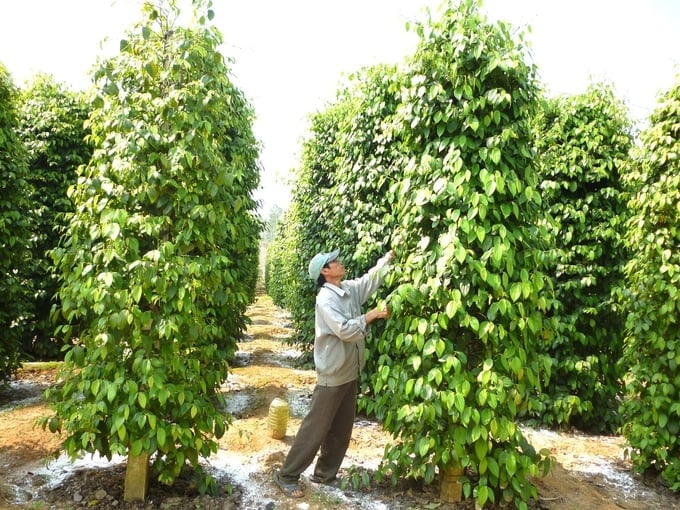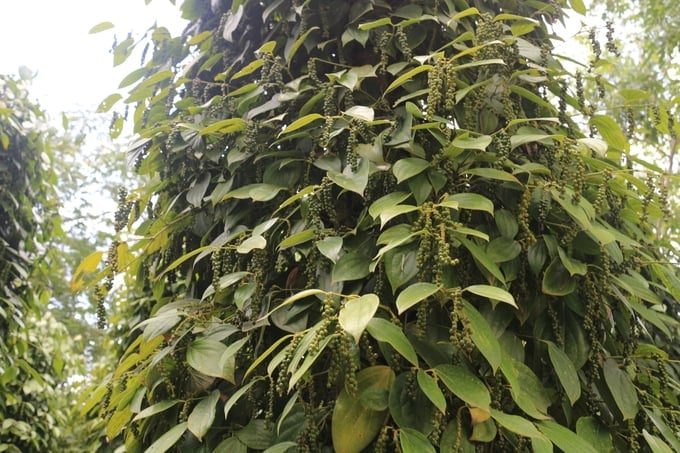(VAN) Despite the sharply rising pepper prices, farmers suffer from low yield due to reduced investment in recent years following a price slump.
Farmers lamenting reduced investment
Amidst the rapidly increasing pepper prices in 2024, the low yields in Binh Dinh’s pepper farms have left farmers lamenting as they reduced investments in pepper farming over the years following the falling pepper prices.
Dang Van Cap, a 75-year-old farmer who owns 7,000 pepper plants in Thach Long 1 village, An Tuong Dong commune, Hoai An district, Binh Dinh province, is regretful that his farm’s yield has decreased by one-third compared to previous years admist the climbing prices.
According to pepper farmer Dang Van Cap, pepper prices have remained at a relatively low level over the years, with the lowest at only 30,000 to 40,000 VND per kilogram, and the highest at only 60,000 to 70,000 VND per kilogram. As a result, pepper farmers in Hoai An district, including his family, have gradually reduced investments into pepper farming activities. Dang Van Cap maintained his 7,000 pepper plants in An Tuong Dong commune with minimal effort to prevent them from dying, and he completely disregarded the yield. Prior to the harvesting season in 2024, he had low expectations for his pepper farm, assuming that the selling price would remain as low as it was in 2023.
Consequently, his family allocated all their resources to cultivate 1,000 pomelo trees and 30 durian trees. Subsequently, each of his pepper plants only yielded nearly 2 kilograms in the harvest; and his family harvested approximately 14 tons of pepper in total.

Dang Van Cap’s 7,000-plant pepper farm located in Thach Long 1 village, An Tuong Dong commune, Hoai An district, Binh Dinh province. Photo: V.D.T.
“Traders in Hoai An district are flocking to local pepper farmers to purchase peppercorns at prices ranging from 165,000 to 170,000 VND per kilogram; whereas the price for grade 1 pepper only ranged from 60,000 to 70,000 VND per kilogram last year. Unfortunately, the yield from my 7,000-plant pepper farm was too low to sell. Even now, traders are still arriving at my farm to place deposits, but I couldn’t accept them. It’s such a pity,” Dang Van Cap shared.
Le Van Chuc, 58, from An Thanh commune, Hoai An district, Binh Dinh province, recalled that 2019 was the year pepper prices “plummeted.” From a peak of 234,000 VND per kilogram in 2016, prices fell to 190,000 VND per kilogram in 2017, and continued a downward trajectory to reach only 100,000 VND per kilogram in 2018. Pepper prices reached their lowest at only 45,000 VND per kilogram in 2019. During this year, pepper farmers neglected their farms out of fear that the revenue from selling pepper would be insufficient to cover the labor costs of harvesting.
Pepper prices in Binh Dinh have failed to recover following this fall. Notably, prices still hovered at 60,000 to 70,000 VND per kilogram by 2023. At this price range, pepper farmers are reluctant to make significant investments. Extensive investments can result in higher yields, which consequently require additional labor for harvesting. However, with pepper prices remaining at 60,000 to 70,000 VND per kilogram, the revenue from selling pepper will be insufficient to offset investment costs, leaving farmers with limited resources to pay laborers.
“As a result, many pepper farms have been neglected and gradually abandoned by farmers. Several farm owners have reluctantly uprooted growing pepper plants to make room for more economically viable fruit trees. Consequently, the local pepper farming area has drastically decreased. Despite the sudden increase in pepper prices this year, farmers have a limited stock to sell,” Le Van Chuc explained.

Pepper prices saw a sudden, rapid increase in 2024; however, farmers have a low stock of pepper for trading. Photo: V.D.T.
Pepper farming area expanded rapidly despite warnings
During the heyday, pepper farming areas across Binh Dinh province expanded rapidly. Hoai An district, a midland area, saw the most significant growth in pepper farming activities. Prior to 2015, pepper farming area covered only 340 hectares in Hoai An district; however, by 2016, this area had grown to 476 hectares, marking a substantial increase of 136 hectares in a single year. The communes with the largest pepper farming areas within Hoai An district include An Thanh, An Huu, An Duc, and An Tin. The pepper farming area in Hoai Nhon town also increased modestly, reaching over 120 hectares by 2019.
During seasons with high and stable pepper prices, Binh Dinh farmers made bold investments and applied advanced agricultural techniques to enhance productivity. Accordingly, farmers cultivated pepper with lower planting densities, efficient water drainage, and utilized sprinkler and drip irrigation systems. Furthermore, they shifted away from chemical fertilizers towards organic manure and bio-fertilizers; and employed Trichoderma fungi alongside compost to effectively manage diseases.
Hoai An district also saw the establishment of the “Pepper Farmers’ Association” and the formation of five pepper farming associations in Hoai Nhon town’s communes and wards—Hoai Hao, Hoai Phu, Hoai Tan, Hoai Thanh, and Hoai Thanh Tay. These organizations aim to guide farmers towards sustainable pepper production. Accordingly, farmers received technical knowledge transfer from local authorities on comprehensive disease management procedures for pepper plants. Consequently, pepper farmers gradually mastered sustainable farming techniques, thereby enhancing productivity, quality and reducing investment costs.

Pepper farming area continued to expand rapidly and uncontrollably in response to the exceptionally high economic returns from pepper. Photo: V.D.T.
However, as farmers raced to cultivate pepper, local governments in pepper-farming regions cautioned against mass planting and excessive expansion within individual households to mitigate future risks. Despite these warnings, the potential of high economic returns has silently driven an uncontrollable and rapid increase in pepper farming area. As a result, when the heyday abruptly ended, pepper farmers struggled as their plants occupy valuable agricultural land without yielding substantial profits.
At the time, the local government of Hoai Nhon town instructed specialized agencies to urgently restructure areas with potential for pepper development, with the aim of facilitating effective management and balancing needs in favor of farmers. The local government also encouraged businesses to invest in the long-term production and development of pepper in combination with investment in production, processing, trading, brand-building and product promotion in order to create a foundation for sustainable pepper production.
In 2024, sudden spikes in pepper prices provide farmers with high incomes, presenting them with an opportunity to re-invest in their pepper farms. While this growth may not indicate a long-term economic recovery, farmers are hopeful that increased investment in their pepper farms will lead to higher pepper yields in the following year, which will translate into greater income opportunities.

Due to the reduced investment in plant care efforts, Dang Van Cap harvested only 2 kilograms of pepper per plant this year. Photo: V.D.T.
“My family expects to earn over 2 billion VND from our 7,000 pepper plants this year. I will use the income from this year’s pepper harvest to make substantial investments for the following year. With increased investment, the yield per plant is expected to reach at least 3 kilograms next year, allowing my family to harvest approximately 21 tons of pepper. Pepper grown in Hoai An district typically fetches a price 10,000 VND per kilogram higher than that grown in other areas. Whether this is due to soil quality or other factors, pepper from Hoai An are both spicier and more aromatic than those from other regions,” Dang Van Cap shared.
“The low pepper prices and unstable income in previous years discouraged farmers in Hoai An district from investing in plant care efforts. As a result, many areas were abandoned or converted to make room for economically viable fruit crops such as green skin pomelo, durian, and coconut. The district’s current pepper farming area has shrunk to approximately 270 hectares, which is only half of its former size,” remarked Vo Duy Tin, Head of Hoai An district’s Department of Agriculture and Rural Development.
Agriculture News | Agri Products Price



